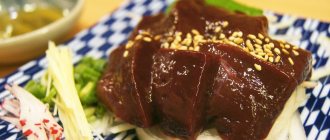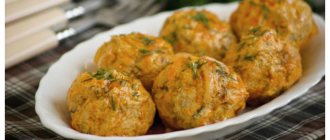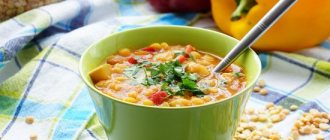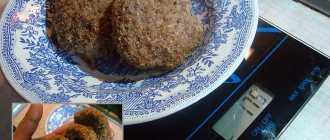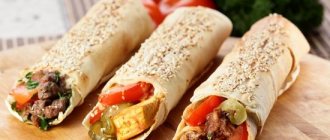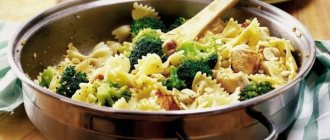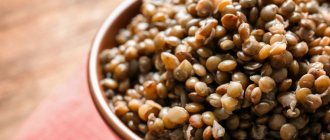Chemical composition and nutritional value
The chemical formula of the product includes:
- fats;
- proteins;
- carbohydrates;
- ash;
- water;
- vitamins;
- amino acids;
- minerals.
Among the amino acids, the following substances predominate:
- glutamine (4.087 g);
- aspartic (2.432 g);
- lysine (2.318 g);
- leucine (2.048 g).
A special role is played by glycine, methionine and arginine, which make up the important substance creatine. It increases endurance, adds strength, and reduces fatigue.
Boiled chicken contains a lot of protein, which is well absorbed by the stomach and is important for athletes who build muscle mass. The nutritional value of the product is 693 kJ. 100 grams contain 36% protein, 8% fat and 0% carbohydrates (daily value). Chicken contains 75.46 g of water and 0.96 g of ash. There is no sugar, fiber or starch in dietary meat. The amount of cholesterol is 70 mg.
https://youtu.be/https://www.youtube.com/watch?v=1M3my4JuDBg
_
Composition of nutrients, BJU
Steamed chicken
| For quantity: 100 grams | ||
| Calories — 175 | Calories from fat - 78 | |
| BJU | ||
| Total fat content | 8.67g | |
| Saturated | 2.39g | |
| Polyunsaturated | 1.73g | |
| Monounsaturated | 3.6g | |
| Cholesterol | 128mg | |
| Total carbohydrate content | 0.03g | |
| Dietary fiber | 0g | |
| Sugar | 0g | |
| Squirrels | 24.23g | |
| Vitamins and microelements | ||
| A - 10.4 µg | C - 0mg | |
| B-6 – 0.46 mg | B-12 - 0.33mcg | |
| D - 0.16 µg | E - 0.22 mg | |
| Calcium 11mcg | Iron 0.89 mg | |
| Magnesium 23.7 mg | Zinc 1.8 mg | |
| Potassium 263 mg | Sodium 132 mg | |
Distribution of calories for BJU:Carbohydrates (1%) Fats (44%) Proteins (55%) | ||
Calorie content and nutritional value of boiled chicken
The calorie content of boiled chicken is 180-200 kcal (per 100 g). If you cook meat with skin, the figure will increase to 218 kcal.
Per 100 g of product there are:
- 24.17 g protein;
- 7.61 g fat;
- 0.64 g carbohydrates.
Each part of a chicken carcass has its own calorie content:
- boiled chicken breast – 115 kcal;
- leg – 160-180 kcal;
- thigh – 180-210 kcal;
- wings – 180-190 kcal.
A sufficient amount of protein and the absence of carbohydrates allow the product to be used as the main ingredient for preparing dietary dishes. To reduce the calorie content of boiled chicken, it is advised:
- remove skin and fat from meat;
- pour out the broth 15-20 minutes after bubbles appear, and then cook it again;
- serve chicken with fresh tomatoes, cucumbers, sweet peppers and parsley to speed up the absorption of fats;
- do not use additional additives in the form of sauces and salty spices.
If possible, it is recommended to buy chicken breast rather than chicken legs.
“Chicken” - in more detail:
- Chicken breast
- Boiled chicken breast
- Skinless chicken breast
- Baked skinless chicken breast
- Cooked skinless chicken breast
- Cooked skinless chicken breast
- Raw chicken breast fillet
- Raw chicken breast fillet
- Baked skinless chicken breast
- Raw boneless chicken breast
- Steamed chicken breast
- Cooked chicken breast
- Chicken breast fillet
- Raw chicken breast fillet
- Boiled chicken breast
- Whole fried chicken leg
- Whole fried chicken wing
- Baked chicken wing with skin
- Fried chicken wing with skin
- Boneless chicken breast
- Raw boneless chicken breast
- Skinless chicken breast
- Grilled chicken breast
- Fried chicken wing
- Fried chicken breast
- Chicken thigh meat
- Whole fried chicken leg
- Baked chicken breast
- Baked chicken wing with skin
- Chicken wing with skin
- Fried chicken breast
- Raw chicken skin
- Raw chicken gizzard
- Raw minced chicken
- Raw chicken heart
- Raw chicken liver
- Raw chicken breast
- Raw chicken breast fillet
- Raw boneless chicken breast
- Raw chicken giblets
- Raw whole chicken
Content of vitamins and microelements
Boiled chicken meat contains the following vitamins:
- A;
- D;
- D3;
- E;
- K;
- IN 1;
- AT 2;
- B4;
- B5;
- B6;
- AT 12;
- RR.
The product contains the most vitamin B4 (72.4 mg). Choline deficiency in the body leads to increased irritability, decreased mental abilities and serious diseases such as gastrointestinal pathologies and sexual dysfunctions.
The product contains vital elements:
- sodium;
- phosphorus;
- potassium;
- calcium;
- iron;
- magnesium;
- manganese;
- zinc.
Boiled chicken contains the most potassium (180 mg) and phosphorus (150 mg). A lack of these substances leads to drowsiness, muscle pain, heart rhythm disturbances and hypotension. Nutrients maintain fluid balance in the body, regulate muscle activity and coordinate heart rhythm. They are sources of energy and support all biological processes in the body.
Calories Chicken. Chemical composition and nutritional value.
Nutritional value and chemical composition of "Chicken".
The table shows the nutritional content (calories, proteins, fats, carbohydrates, vitamins and minerals) per 100 grams of edible portion.
| Nutrient | Quantity | Norm** | % of the norm in 100 g | % of the norm in 100 kcal | 100% normal |
| Calorie content | 113 kcal | 1684 kcal | 6.7% | 5.9% | 1490 g |
| Squirrels | 23.6 g | 76 g | 31.1% | 27.5% | 322 g |
| Fats | 1.9 g | 56 g | 3.4% | 3% | 2947 g |
| Carbohydrates | 0.4 g | 219 g | 0.2% | 0.2% | 54750 g |
| Water | 73 g | 2273 g | 3.2% | 2.8% | 3114 g |
| Ash | 1.1 g | ~ | |||
| Vitamins | |||||
| Vitamin B1, thiamine | 0.07 mg | 1.5 mg | 4.7% | 4.2% | 2143 g |
| Vitamin B2, riboflavin | 0.07 mg | 1.8 mg | 3.9% | 3.5% | 2571 g |
| Vitamin RR, NE | 7.69 mg | 20 mg | 38.5% | 34.1% | 260 g |
| Niacin | 10.9 mg | ~ | |||
| Macronutrients | |||||
| Potassium, K | 292 mg | 2500 mg | 11.7% | 10.4% | 856 g |
| Calcium, Ca | 8 mg | 1000 mg | 0.8% | 0.7% | 12500 g |
| Magnesium, Mg | 86 mg | 400 mg | 21.5% | 19% | 465 g |
| Sodium, Na | 60 mg | 1300 mg | 4.6% | 4.1% | 2167 g |
| Phosphorus, P | 171 mg | 800 mg | 21.4% | 18.9% | 468 g |
| Chlorine, Cl | 77 mg | 2300 mg | 3.3% | 2.9% | 2987 g |
| Microelements | |||||
| Iron, Fe | 1.4 mg | 18 mg | 7.8% | 6.9% | 1286 g |
| Yod, I | 6 mcg | 150 mcg | 4% | 3.5% | 2500 g |
| Cobalt, Co | 9 mcg | 10 mcg | 90% | 79.6% | 111 g |
| Manganese, Mn | 0.02 mg | 2 mg | 1% | 0.9% | 10000 g |
| Copper, Cu | 80 mcg | 1000 mcg | 8% | 7.1% | 1250 g |
| Molybdenum, Mo | 11 mcg | 70 mcg | 15.7% | 13.9% | 636 g |
| Fluorine, F | 130 mcg | 4000 mcg | 3.3% | 2.9% | 3077 g |
| Chromium, Cr | 25 mcg | 50 mcg | 50% | 44.2% | 200 g |
| Zinc, Zn | 1.3 mg | 12 mg | 10.8% | 9.6% | 923 g |
| Essential amino acids | |||||
| Arginine* | 1.82 g | ~ | |||
| Valin | 1.3 g | ~ | |||
| Histidine* | 1.32 g | ~ | |||
| Isoleucine | 1.13 g | ~ | |||
| Leucine | 1.98 g | ~ | |||
| Lysine | 2.64 g | ~ | |||
| Methionine | 0.45 g | ~ | |||
| Methionine + Cysteine | 0.87 g | ~ | |||
| Threonine | 1.11 g | ~ | |||
| Tryptophan | 0.38 g | ~ | |||
| Phenylalanine | 1.06 g | ~ | |||
| Phenylalanine+Tyrosine | 1.96 g | ~ | |||
| Nonessential amino acids | |||||
| Alanin | 1.3 g | ~ | |||
| Aspartic acid | 1.94 g | ~ | |||
| Hydroxyproline | 0.21 g | ~ | |||
| Glycine | 0.92 g | ~ | |||
| Glutamic acid | 2.83 g | ~ | |||
| Proline | 1.01 g | ~ | |||
| Serin | 1.01 g | ~ | |||
| Tyrosine | 0.9 g | ~ | |||
| Cysteine | 0.43 g | ~ | |||
| Sterols (sterols) | |||||
| Cholesterol | 10 mg | max 300 mg | |||
| Saturated fatty acids | |||||
| Saturated fatty acids | 0.51 g | max 18.7 g | |||
| 14:0 Miristinovaya | 0.01 g | ~ | |||
| 16:0 Palmitinaya | 0.4 g | ~ | |||
| 18:0 Stearic | 0.09 g | ~ | |||
| 20:0 Arakhinovaya | 0.01 g | ~ | |||
| Monounsaturated fatty acids | 0.71 g | min 16.8 g | 4.2% | 3.7% | |
| 16:1 Palmitoleic | 0.12 g | ~ | |||
| 17:1 Heptadecene | 0.01 g | ~ | |||
| 18:1 Oleic (omega-9) | 0.58 g | ~ | |||
| Polyunsaturated fatty acids | 0.22 g | from 11.2 to 20.6 g | 2% | 1.8% | |
| 18:2 Linolevaya | 0.19 g | ~ | |||
| 18:3 Linolenic | 0.01 g | ~ | |||
| 20:4 Arachidonic | 0.02 g | ~ | |||
| Omega-3 fatty acids | 0.01 g | from 0.9 to 3.7 g | 1.1% | 1% | |
| Omega-6 fatty acids | 0.21 g | from 4.7 to 16.8 g | 4.5% | 4% |
The energy value of Chicken is 113 kcal.
Primary Source: Created in the application by the user. Read more.
** This table shows the average levels of vitamins and minerals for an adult. If you want to know the norms taking into account your gender, age and other factors, then use the “My Healthy Diet” application.
Daily consumption of poultry meat
Chicken meat is much more nutritious than, for example, beef. It is recommended for those who want to normalize weight. However, for good functioning of the body, one should include in the diet not only poultry, but also rabbit and pork meat.
Experts do not recommend eating more than 210-220 g per day. This is the optimal amount for an adult who is interested in sports or spends a lot of time doing physical labor.
For children under 3 years old, 75 g of chicken per day is enough. Boys and girls aged 4 to 7 years can eat up to 100-120 g of product. The same amount is suitable for an elderly person.
Calories Chicken, stewed. Chemical composition and nutritional value.
Nutritional value and chemical composition of "Chicken, stewed".
The table shows the nutritional content (calories, proteins, fats, carbohydrates, vitamins and minerals) per 100 grams of edible portion.
| Nutrient | Quantity | Norm** | % of the norm in 100 g | % of the norm in 100 kcal | 100% normal |
| Calorie content | 285 kcal | 1684 kcal | 16.9% | 5.9% | 591 g |
| Squirrels | 26.88 g | 76 g | 35.4% | 12.4% | 283 g |
| Fats | 18.87 g | 56 g | 33.7% | 11.8% | 297 g |
| Water | 53.07 g | 2273 g | 2.3% | 0.8% | 4283 g |
| Ash | 1.18 g | ~ | |||
| Vitamins | |||||
| Vitamin A, RE | 39 mcg | 900 mcg | 4.3% | 1.5% | 2308 g |
| Retinol | 0.039 mg | ~ | |||
| Vitamin B1, thiamine | 0.094 mg | 1.5 mg | 6.3% | 2.2% | 1596 g |
| Vitamin B2, riboflavin | 0.235 mg | 1.8 mg | 13.1% | 4.6% | 766 g |
| Vitamin B5, pantothenic | 0.753 mg | 5 mg | 15.1% | 5.3% | 664 g |
| Vitamin B6, pyridoxine | 0.25 mg | 2 mg | 12.5% | 4.4% | 800 g |
| Vitamin B9, folates | 5 mcg | 400 mcg | 1.3% | 0.5% | 8000 g |
| Vitamin B12, cobalamin | 0.23 mcg | 3 mcg | 7.7% | 2.7% | 1304 g |
| Vitamin RR, NE | 5.798 mg | 20 mg | 29% | 10.2% | 345 g |
| Macronutrients | |||||
| Potassium, K | 182 mg | 2500 mg | 7.3% | 2.6% | 1374 g |
| Calcium, Ca | 13 mg | 1000 mg | 1.3% | 0.5% | 7692 g |
| Magnesium, Mg | 20 mg | 400 mg | 5% | 1.8% | 2000 g |
| Sodium, Na | 73 mg | 1300 mg | 5.6% | 2% | 1781 |
| Sera, S | 268.8 mg | 1000 mg | 26.9% | 9.4% | 372 g |
| Phosphorus, P | 180 mg | 800 mg | 22.5% | 7.9% | 444 g |
| Microelements | |||||
| Iron, Fe | 1.37 mg | 18 mg | 7.6% | 2.7% | 1314 g |
| Manganese, Mn | 0.021 mg | 2 mg | 1.1% | 0.4% | 9524 g |
| Copper, Cu | 100 mcg | 1000 mcg | 10% | 3.5% | 1000 g |
| Selenium, Se | 19.7 mcg | 55 mcg | 35.8% | 12.6% | 279 g |
| Zinc, Zn | 1.77 mg | 12 mg | 14.8% | 5.2% | 678 g |
| Essential amino acids | |||||
| Arginine* | 1.68 g | ~ | |||
| Valin | 1.307 g | ~ | |||
| Histidine* | 0.793 g | ~ | |||
| Isoleucine | 1.348 g | ~ | |||
| Leucine | 1.961 g | ~ | |||
| Lysine | 2.197 g | ~ | |||
| Methionine | 0.717 g | ~ | |||
| Threonine | 1.113 g | ~ | |||
| Tryptophan | 0.301 g | ~ | |||
| Phenylalanine | 1.046 g | ~ | |||
| Nonessential amino acids | |||||
| Alanin | 1.559 g | ~ | |||
| Aspartic acid | 2.397 g | ~ | |||
| Glycine | 1.702 g | ~ | |||
| Glutamic acid | 3.938 g | ~ | |||
| Proline | 1.286 g | ~ | |||
| Serin | 0.946 g | ~ | |||
| Tyrosine | 0.869 g | ~ | |||
| Cysteine | 0.357 g | ~ | |||
| Sterols (sterols) | |||||
| Cholesterol | 79 mg | max 300 mg | |||
| Saturated fatty acids | |||||
| Saturated fatty acids | 5.11 g | max 18.7 g | |||
| 12:0 Lauric | 0.03 g | ~ | |||
| 14:0 Miristinovaya | 0.14 g | ~ | |||
| 16:0 Palmitinaya | 3.73 g | ~ | |||
| 18:0 Stearic | 1.07 g | ~ | |||
| Monounsaturated fatty acids | 7.19 g | min 16.8 g | 42.8% | 15% | |
| 16:1 Palmitoleic | 1 g | ~ | |||
| 18:1 Oleic (omega-9) | 5.92 g | ~ | |||
| 20:1 Gadoleic (omega-9) | 0.17 g | ~ | |||
| Polyunsaturated fatty acids | 4.23 g | from 11.2 to 20.6 g | 37.8% | 13.3% | |
| 18:2 Linolevaya | 3.53 g | ~ | |||
| 18:3 Linolenic | 0.16 g | ~ | |||
| 20:4 Arachidonic | 0.25 g | ~ | |||
| 20:5 Eicosapentaenoic acid (EPA), Omega-3 | 0.02 g | ~ | |||
| Omega-3 fatty acids | 0.3 g | from 0.9 to 3.7 g | 33.3% | 11.7% | |
| 22:5 Docosapentaenoic acid (DPA), Omega-3 | 0.04 g | ~ | |||
| 22:6 Docosahexaenoic acid (DHA), Omega-3 | 0.08 g | ~ | |||
| Omega-6 fatty acids | 3.78 g | from 4.7 to 16.8 g | 80.4% | 28.2% |
The energy value of stewed chicken is 285 kcal.
- unit (yield from 1 lb ready-to-cook chicken) = 178 g (507.3 kcal)
- 0.5 chicken, bone removed = 261 g (743.9 kcal)
Primary source: USDA National Nutrient Database for Standard Reference. Read more.
** This table shows the average levels of vitamins and minerals for an adult. If you want to know the norms taking into account your gender, age and other factors, then use the “My Healthy Diet” application.
